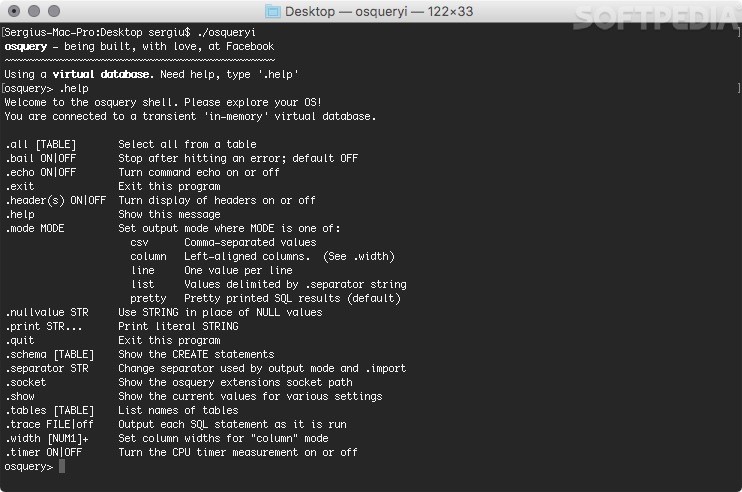

#Osquery golang code
Now you went from writing bad code to building bad infrastructure.īecause it drives a lot of new spend, it drives a lot of new hiring… So a lot of people get addicted to all the flourishment of money, and marketing, and it’s just a lot of buzz that people are attaching their assignment to, when honestly it’s not gonna necessarily solve their problem."īingo. "We’re gonna break up and somehow find the engineering discipline we never had in the first place. Kelsey Hightower, one of the leading voices behind Kubernetes, put it beautifully in 2020: I wrote an ode to The Majestic Monolith way back in 2016. It's been eating brains since the dark days of J2EE (remote server beans, anyone?) through the WS-Deathstar nonsense, and now in the form of microservices and serverless.īut this third wave seems finally to have crested. Another strain of an intellectual contagion that just refuses to die. In many ways, microservices is a zombie architecture. An organizational pattern for dealing with intra-company communication at crazy scale when API calls beat scheduling coordination meetings.īut, as with many good ideas, this pattern turned toxic as soon as it was adopted outside its original context, and wrecked havoc once it got pushed into the internals of single-application architectures. Second, Osquery will generate a file carve GUID which is a unique value for that file carve request. First, Osquery will calculate the size of the file to determine if the file is smaller than the configured readmax value. The far more reasonable prior to microservices. When Osquery receives the file carve request it will perform the following actions described in this section. What makes this story unique is that Amazon was the original poster child for service-oriented architectures. That really sums up so much of the microservices craze that was tearing through the tech industry for a while: IN THEORY. Now the real-world results of all this theory are finally in, and it's clear that in practice, microservices pose perhaps the biggest siren song for needlessly complicating your system. However, the way we used some components caused us to hit a hard scaling limit at around 5% of the expected load." In theory, this would allow us to scale each service component independently. Here's the telling bit: "We designed our initial solution as a distributed system using serverless components. What a win!īut beyond celebrating their good sense, I think there's a bigger point here that applies to our entire industry. This move saved them a staggering 90%(!!) on operating costs, and simplified the system too.
#Osquery golang full
Exported Fieldsįor a full list of fields that can be returned in osquery results, see the Exported Fields reference in the Kibana documentation.The Prime Video team at Amazon has published a rather remarkable case study on their decision to dump their serverless, microservices architecture and replace it with a monolith instead.
#Osquery golang how to
This includes information about required privileges how to run, schedule, and save queries how to map osquery fields to ECS and other useful information about managing Osquery with this integration. Documentationįor information about using Osquery, see the Osquery Kibana documentation. Osquery results are stored in Elasticsearch, so that you can use the power of the stack to search, analyze, and visualize Osquery data.

View a history of past queries and their results.Run live queries for one or more agents.This integration adds an Osquery UI in Kibana where you can: With this integration, you can centrally manage Osquery deployments to Elastic Agents in your Fleet and query host data through distributed SQL. Quick start: Get application traces into the Elastic Stack.Quick start: Get logs, metrics, and uptime data into the Elastic Stack.See the integrations quick start guides to get started:


 0 kommentar(er)
0 kommentar(er)
